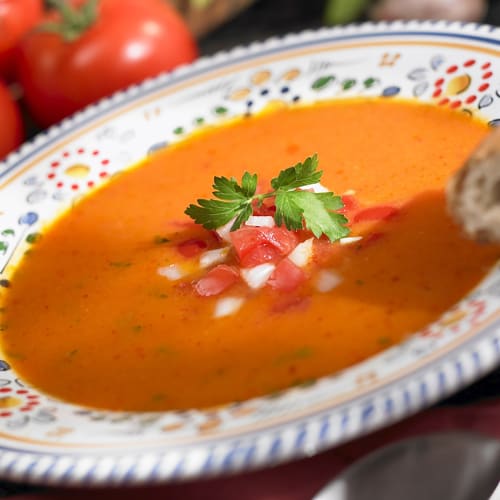Three Cool Soup Sisters – Gazpacho, Salmorejo and Ajo Blanco
Jonathan Harris | August 2019




Summers in Andalucía can be brutally hot. In sunny Sevilla, July temps over 110°F are a part of daily life. No wonder Sevillanos usually wait until after sunset to socialize! Last year I was wandering back to my hotel at midnight, past the massive Santa Maria de la Sede Cathedral with its beautiful Moorish Giralda tower. Lining the street were restaurants and cafés, filled at that late hour with families enjoying the relatively cool night air. I marveled at the site of small children playing together while their parents chatted, hours after I would have put my kids to bed back home.
With its famously hot weather, it is no wonder that Andalucía is the birthplace of Spain’s miraculously refreshing chilled soups. Tomato gazpacho is known across the world, though with her fame come many questionable variations that would scandalize a true Andalucian. Gazpacho’s close sibling is salmorejo, a thicker chilled soup garnished with jamón and egg. And my current favorite is the elegant ajo blanco, a creamy white soup made with almonds and fresh garlic, typically garnished with sliced grapes.

All three chilled soups find their origins in a simple dish introduced by the Romans over two thousand years ago. Gazpacho began as a hearty peasant dish, mixing bread, olive oil and garlic. The almonds in ajo blanco arrived with the Moors 1,000 years later. Eventually the Spanish explorers returned from Latin America with peppers and tomatoes which were soon added to the mix. As with much of Spanish cuisine, gazpacho is a blend of influences from the many cultures that have called Spain home over the millennia.
I’ll start with some do’s and don’ts for gazpacho. Because the recipes are so simple, it is critical to start with the freshest, highest quality ingredients. If you can’t source super ripe, sweet tomatoes, don’t even start thinking about making gazpacho. You can use any color tomato you like – I like yellow tomatoes because of their lower acidity – but they must be at the peak of ripeness. While healthy and refreshing, gazpacho is not a veggie smoothie or a version of V-8, so don’t add tomato juice or water. Avoid ice cubes because they can water down gazpacho – you want it to be somewhat thick.
Now for the do’s. Using excellent extra virgin olive oil is key. Olive oil adds richness and flavor to the soup, so choose an oil that you enjoy. I like to add olive oil made with Picual olives, which has a bold, peppery flavor. Other people prefer a milder, fruitier oil such as Arbequina. It’s up to you to choose your favorite, just avoid bland grocery store blends.
Sherry vinegar is another key ingredient. This barrel-aged vinegar is bone-dry and has a bright acidity and complex flavor which elevates gazpacho to a new level. If you like you can also add a dash of sherry wine, choose an aromatic style such as Oloroso or Amontillado.
Bread is very important as well, it adds a smoothness and body, and offsets the acidity of the tomatoes and vinegar. In Spain they usually use 'pan de ayer,' stale bread from yesterday. The bread is soaked in water for a couple of hours, with the extra water squeezed out right before preparation. Why soak the bread? I guess it helps the bread to blend in, but with modern blenders this isn’t a big factor. That said, why mess with tradition? Do use a crusty European style bread like a baguette, it makes a big difference.
Speaking of blenders, we recommend using a vertical blender, the more powerful the better. You could use an immersion blender, but it won’t create a smooth soup. If you find that your blender doesn’t blend to your preferred smoothness, you can pour the gazpacho through a sieve.

Now that we have the basics down, what is the deal with salmorejo and ajo blanco? Salmorejo is typical of the beautiful city of Córdoba and has become a favorite of mine when I want a refreshing yet substantial meal. Very similar to gazpacho, salmorejo has a lot more bread which makes it substantially thicker. Whereas you can toss back a glass of gazpacho with no problem, salmorejo requires a spoon. In Córdoba, salmorejo is garnished with slices of jamón and hard-boiled egg. Serve with fresh baked bread and a bottle of vino and you have a delicious summer lunch!
I find ajo blanco to be the most elegant of the three chilled soups. Bright white and silky smooth, it is typically garnished with sliced green grapes. Literally translated as “white garlic," this soup is a blend of blanched almonds, olive oil, bread, vinegar and garlic. Because the bold flavor of tomatoes is absent, the garlic flavor comes to the fore. Most recipes only include one or two cloves of garlic, which lends a mild aroma and spiciness. Garlic lovers, or those fending off vampires, sometimes add five or six cloves for a bolder version.
All three of these sister soups are remarkably healthy. Fresh vegetables and extra virgin olive oil are famously good for you, as are the blanched almonds in ajo blanco. For gazpacho and salmorejo you can adjust the amount of bread and salt to your liking, though I’d advise against removing them entirely.
Andalucía is defined by hot summer days and relatively cool, dry evenings. This is the birthplace of the siesta, a mid-afternoon rest during the hottest time of the day, and dinners that last late into the night. For thousands of years, variations of gazpacho have cooled and refreshed Andalucians. I encourage you to serve the three sister soups of this wonderful region to cool off your summer days.

